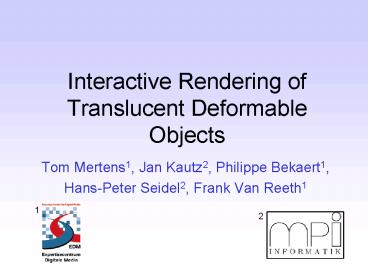Interactive Rendering of Translucent Deformable Objects PowerPoint PPT Presentation
1 / 32
Title: Interactive Rendering of Translucent Deformable Objects
1
Interactive Rendering of Translucent Deformable
Objects
- Tom Mertens1, Jan Kautz2, Philippe Bekaert1,
- Hans-Peter Seidel2, Frank Van Reeth1
1
2
2
Overview
- Goal
- Previous work
- Translucency model
- Our method
- Implementation
- Discussion, results and future work
3
Problem Translucency
- BRDF
BSSRDF
4
(No Transcript)
5
Previous work
- Jensen et al. (SIGGRAPH 01)
- BSSRDF model
- Jensen et al. (SIGGRAPH 02)
- fast, production quality rendering
- Lensch et al. (PG 02), Hao et al. (GI 03), Carr
et al. (GHW03), Sloan et al. (SIGGRAPH02-03) - interactive, real-time rendering with
precomputation - Our paper
- interactive rendering
- varying geometry and material (no precomputation)
6
BSSRDF model
- introduced by Jensen et al. (SIGGRAPH01)
- multiple scattering
- materials with high albedo marble, milk, wax,
skin,
function of distance
7
BSSRDF model
- introduced by Jensen et al. (SIGGRAPH01)
- multiple scattering
- materials with high albedo marble, milk, wax,
skin,
function of distance
8
Integrating the BSSRDF
- hierarchical approach (Jensen et al. 02)
- decouple light and surface sampling,
- decouple light sampling from geometry
- 2-pass method
- irradiance sampling integration with octree
- limitation rebuilding samples octree
- our method
- integration hierarchical radiosity
- mesh based beneficial for geometry updates
- hierarchy clustered triangles
- form factor for BSSRDF fast local integration
9
Our Method
- boundary element method
10
Our Method
- boundary element method
discretized radiance
discretized irradiance
11
Our Method
- boundary element method
discretized radiance
form factor
discretized irradiance
12
example
13
sample irradiance
14
pull irradiance
15
link roots
16
subdivide link
17
subdivide link again
18
gather
19
push
20
Hierarchical Evaluation
- hierarchy clustered triangles
- tree hierarchy
- subdivision 4-to-1 splits
- face clustering
- evaluation hierarchical radiosity
- irradiance sampling pull
- construct link hierarchy
- gather over each link
- push average at vertices
- oracle solid angle
- interactions at different levels
- speed advantage
21
Form Factor
area integral
- (mid)point to triangle
- semi-analytical
- Taylor expansion
- advantages
- fast
- accurate
- noiseless
- indispensable for local integration
- more distant 1 sample
integral over edges
recursive midpoint
22
Form Factor
- point to triangle
- semi-analytical
- Taylor expansion
- advantages
- fast
- accurate
- noiseless
- indispensable for local integration
- more distant 1 sample
23
Form Factor
- point to triangle
- semi-analytical
- Taylor expansion
- advantages
- fast
- accurate
- noiseless
- indispensable for local integration
- more distant 1 sample
point sampling
form factor
24
Implementation
- GPU
- fresnel
- tone mapping
- shadow map
- irradiance
- point light ( shadow)
- environment map
- stored links
- incremental updates
- promote/demote links
- real-time frame rate
- render on-the-fly
- instant feedback
- less memory overhead
- interactive frame rate
25
Results
- 5-10 fps for 10-20K tris models
- dual Xeon 2.4Ghz ATI Radeon 9700
- Demo video
material change
candle twist
shadow leak
Perlin noise deformation
26
(No Transcript)
27
(No Transcript)
28
(No Transcript)
29
(No Transcript)
30
Discussion
- practical technique for interactive applications
- speed advantage over previous hierarchical
algorithm - gathering in higher levels
- efficient local integration
- consistent hierarchy after deformation
- limitation mesh
- needs hierarchy
- limited by resolution
- fixed topology
- interactive applications often mesh-based anyway
31
Future Work
- recycle radiosity techniques
- adaptive meshing, high order interpolation,
- improved oracle function
- varying topology
- full GPU implementation
- non-homogeneous media
32
Acknowledgements
- Jens Vorsatz (mesh hierarchies)
- P. Debevec (light probes)
- funding
- European Regional Development Fund
- Marie Curie doctoral fellowship

